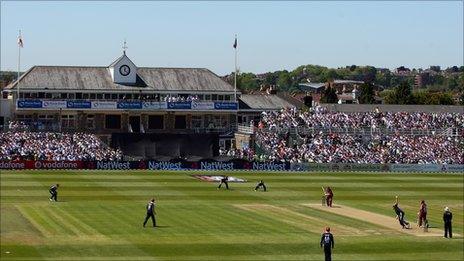England v India: Glos end four-year international exile
- Published

Gloucestershire's new pavilion opened in August 2013
After a four-year wait, Gloucestershire are finally ready to welcome international cricket back to Bristol.
When England host India on Monday, it will be the first one-day international at Nevil Road since 2010, when Bangladesh were the visitors.
The time in-between has seen Gloucestershire face an arduous battle to rebuild and reshape the club both on and off the field.
BBC Sport looks back at the key issues that have shaped the changing face of the county.
New-look Nevil Road
Gloucestershire first hosted international cricket in 1983, when New Zealand and Sri Lanka travelled to Bristol, and the county began to reap the financial benefits that came from the bigger crowds and corporate deals.
However, towards the end of the last decade, the club realised their stadium was no longer fit to the meet commercial demands.
Although it was steeped in history, the ageing facilities of the ground first bought by WG Grace in 1889 were leaving Gloucestershire in a precarious financial position.
"We had to scale back because we saw this problem coming," explains chief executive Will Brown. "Essentially we weren't raising any income."

Gloucestershire's building work at Nevil Road was approved in May 2012
In order to ensure the club's financial stability, they set about completely rejuvenating their stadium. But it proved to be an up-hill battle.
Their original project was rejected by Bristol City Council, with a debate rumbling over the proposed building of flats on land they had sold to the south of the ground.
With the finances now severely stretched by the delays, there seemed to be a real possibility that the club would disappear altogether from Bristol.
However, after the agony of continuous set-backs, work finally started on the club's scaled-down plans in May 2012.
Around £6m was spent on building a brand new pavilion, as well as increasing the ground's maximum capacity to over 16,000, meaning the club now have a glossy home to show off on the international stage.
Club captain Michael Klinger has witnessed the changes that have taken place since he arrived 18 months ago and he told BBC Sport: "For it to improve so much over I short period of time is great.
"The ground is looking a treat. In terms of facilities it's first class."
Making Bristol love Gloucestershire
After the problems with the planning and commissioning of the new development, relations with the local community were fractious.
For the club, the anti-development members of the community were preventing them from hosting international cricket, which would bring certain prosperity and revenue.
For the locals, the expansion was unnecessary and unwanted, and would stick out like a sore thumb in the residential area in which the ground is located.
Nevil Road in the beginning | |
|---|---|
Gloucestershire's home ground in Bristol was bought by legendary England all-rounder WG Grace in 1889 and was originally called the Ashley Down Ground, after its location in the city. |
However, Gloucestershire wanted to stay in their original Bristol home, and they took it upon themselves to fully integrate within the community.
The club offered their services to local schools, and the ground's facilities were opened up for local community groups. There was also a drive to get more people into the ground - to create more 'fans' from local residents.
"It was clear to everybody that there was room for improvement," says head of community engagement Roz Hutchings.
"But since community engagement has become a real focus of the club in the last 18 months, things are really moving at a fast pace.
"People now know that the County Ground is here and that we are open to everyone."
Out with the old, in with the new

Gloucestershire are mid-table in Division Two and have reached the knock-out stages of the One-Day Cup
Gloucestershire first hosted an England international at Nevil Road in 1999, coinciding with a period of success on the field for the county.
They won nine one-day trophies in a five-year period, reached the finals of the Twenty20 in 2007 and played in the top division of the Championship from 2003 to 2005.
As former Gloucestershire bowler Steve Kirby explains: "At that time, they had quite possibly reinvented what one-day cricket was all about."
However, with the development of the ground at the forefront of the club's plans, the playing budget had to give.
Senior players Martin Ball, Phil Weston and Jon Lewis all left, and Gloucestershire were forced to rely on a host on a host of youngsters.
However, director of cricket John Bracewell persevered with his young players in the hope that they would one day come good.
After a succession of seasons without challenging in Division Two, they are now pushing up the table with the help of youngsters such as Craig Miles, Chris Dent and Will Tavaré.
"It goes in cycles," says Kirby. "Bringing on these young players, giving them experience takes time.
"But I believe we're now going to see the fruits of that."
The future
After all that radical change, you would expect Gloucestershire could rest easy for a while.
But with increased competition from grounds around the country to stage lucrative internationals, Gloucestershire still have to keep improving.
"There are some more practical things we need to do" says Brown. "The first of those is floodlights.
"On top of that we're starting the process of bidding for future England internationals, and the World Cup in 2019."
It appears Bristol's cricket revolution has only just begun.
- Attribution
- Published26 August 2013

- Attribution
- Published31 May 2012
.jpg)
- Published12 January 2012
